2012 Peugeot 3008 Hybrid 4 check engine
[x] Cancel search: check enginePage 100 of 284
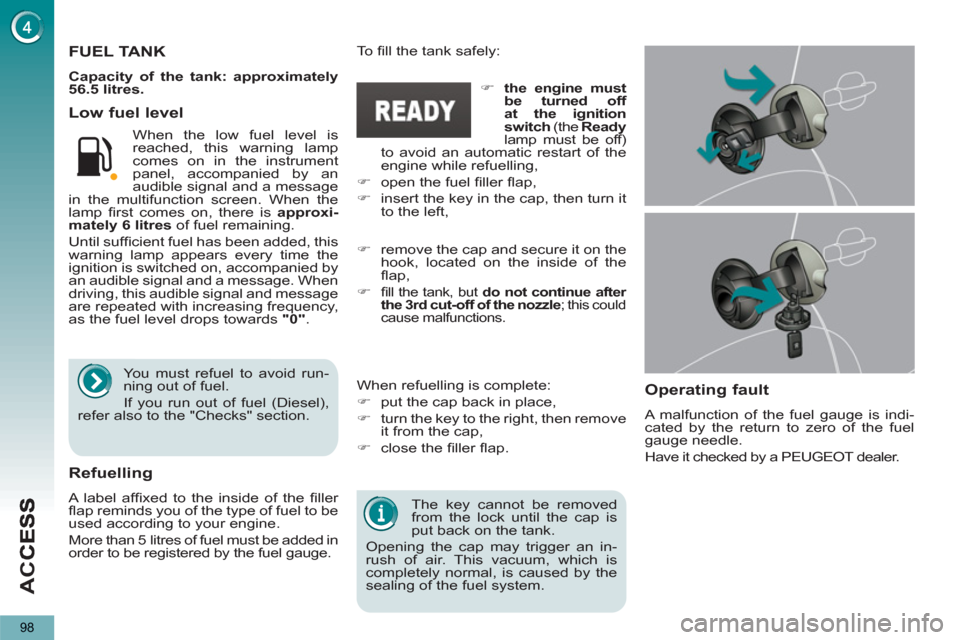
AC
C
98
The key cannot be removed
from the lock until the cap is
put back on the tank.
Opening the cap may trigger an in-
rush of air. This vacuum, which is
completely normal, is caused by the
sealing of the fuel system.
FUEL TANK
Capacity of the tank: approximately
56.5 litres.
To fi ll the tank safely:
When refuelling is complete:
�)
put the cap back in place,
�)
turn the key to the right, then remove
it from the cap,
�)
close the fi ller fl ap.
�)
remove the cap and secure it on the
hook, located on the inside of the
fl ap,
�)
fi ll the tank, but do not continue after
the 3rd cut-off of the nozzle
; this could
cause malfunctions.
Low fuel level
Operatin
g fault
A malfunction of the fuel gauge is indi-
cated by the return to zero of the fuel
gauge needle.
Have it checked by a PEUGEOT dealer.
Refuelling
A label affi xed to the inside of the fi ller
fl ap reminds you of the type of fuel to be
used according to your engine.
More than 5 litres of fuel must be added in
order to be registered by the fuel gauge. When the low fuel level is
reached, this warning lamp
comes on in the instrument
panel, accompanied by an
audible signal and a message
in the multifunction screen. When the
lamp fi rst comes on, there is approxi-
mately
6 litres
of fuel remaining.
Until suffi cient fuel has been added, this
warning lamp appears every time the
ignition is switched on, accompanied by
an audible signal and a message. When
driving, this audible signal and message
are repeated with increasing frequency,
as the fuel level drops towards "0"
.
You must refuel to avoid run-
ning out of fuel.
If you run out of fuel (Diesel),
refer also to the "Checks" section.
�)
the engine must
be turned off
at the ignition
switch
(the Ready
lamp must be off)
to avoid an automatic restart of the
engine while refuelling,
�)
open the fuel fi ller fl ap,
�)
insert the key in the cap, then turn it
to the left,
Page 101 of 284
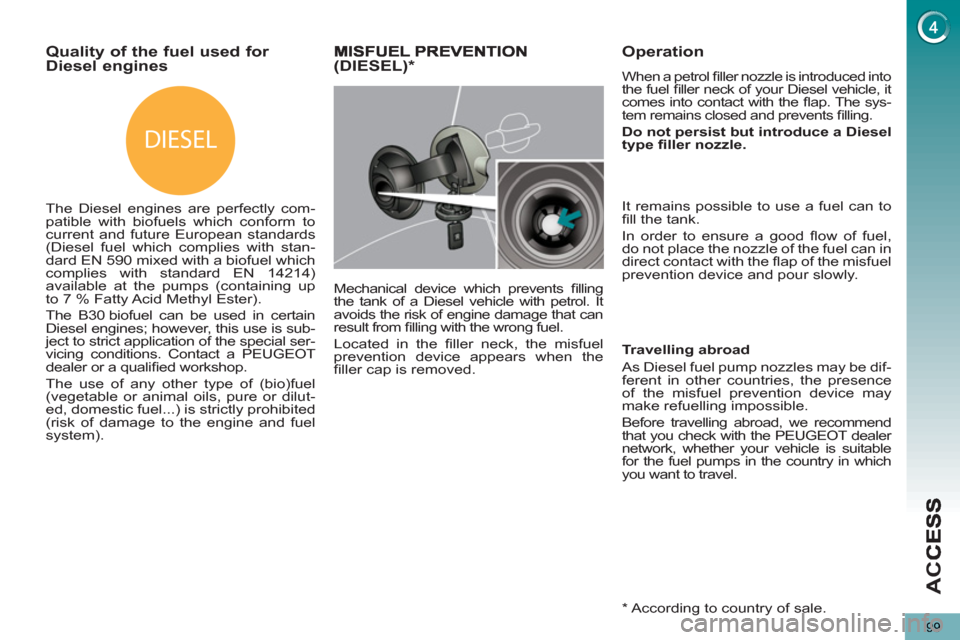
DIESEL
AC
C
99
Quality of the fuel used for Diesel engines
The Diesel engines are perfectly com-
patible with biofuels which conform to
current and future European standards
(Diesel fuel which complies with stan-
dard EN 590 mixed with a biofuel which
complies with standard EN 14214)
available at the pumps (containing up
to 7 % Fatty Acid Methyl Ester).
The B30 biofuel can be used in certain
Diesel engines; however, this use is sub-
ject to strict application of the special ser-
vicing conditions. Contact a PEUGEOT
dealer or a qualifi ed workshop.
The use of any other type of (bio)fuel
(vegetable or animal oils, pure or dilut-
ed, domestic fuel...) is strictly prohibited
(risk of damage to the engine and fuel
system).
(DIESEL)
*
Mechanical device which prevents fi lling
the tank of a Diesel vehicle with petrol. It
avoids the risk of engine damage that can
result from fi lling with the wrong fuel.
Located in the fi ller neck, the misfuel
prevention device appears when the
fi ller cap is removed.
Operation
When a petrol fi ller nozzle is introduced into
the fuel fi ller neck of your Diesel vehicle, it
comes into contact with the fl ap. The sys-
tem remains closed and prevents fi lling.
Do not persist but introduce a Diesel
type fi ller nozzle.
It remains possible to use a fuel can to
fi ll the tank.
In order to ensure a good fl ow of fuel,
do not place the nozzle of the fuel can in
direct contact with the fl ap of the misfuel
prevention device and pour slowly.
*
According to country of sale.
Travelling abroad
As Diesel fuel pump nozzles may be dif-
ferent in other countries, the presence
of the misfuel prevention device may
make refuelling impossible.
Before travelling abroad, we recommend
that you check with the PEUGEOT dealer
network, whether your vehicle is suitable
for the fuel pumps in the country in which
you want to travel.
Page 137 of 284
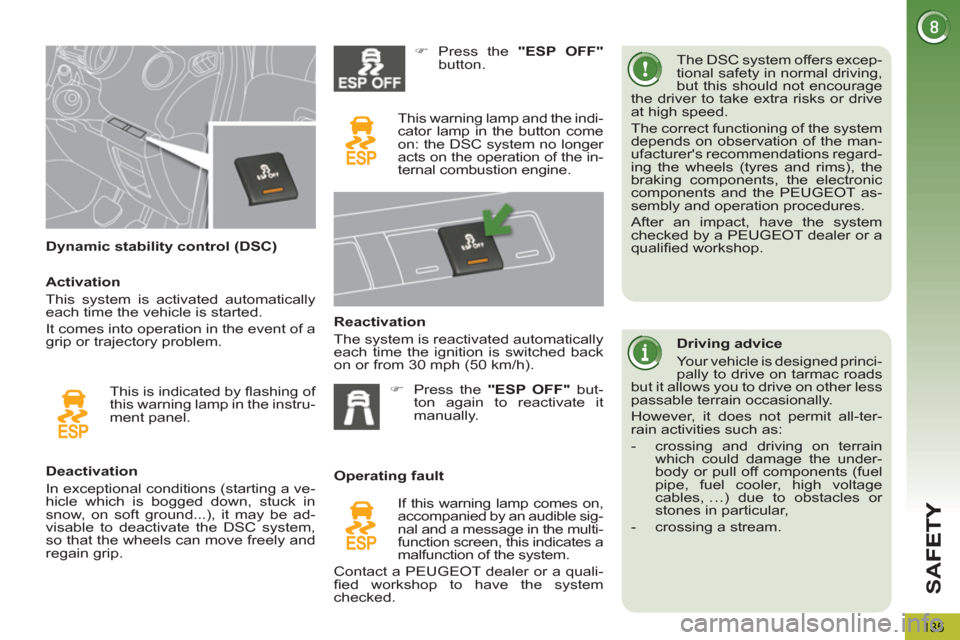
SA
F
135
Dynamic stability control (DSC) The DSC system offers excep-
tional safety in normal driving,
but this should not encourage
the driver to take extra risks or drive
at high speed.
The correct functioning of the system
depends on observation of the man-
ufacturer's recommendations regard-
ing the wheels (tyres and rims), the
braking components, the electronic
components and the PEUGEOT as-
sembly and operation procedures.
After an impact, have the system
checked by a PEUGEOT dealer or a
qualifi ed workshop.
Deactivation
In exceptional conditions (starting a ve-
hicle which is bogged down, stuck in
snow, on soft ground...), it may be ad-
visable to deactivate the DSC system,
so that the wheels can move freely and
regain grip.
�)
Press the "ESP OFF"
button.
This warning lamp and the indi-
cator lamp in the button come
on: the DSC system no longer
acts on the operation of the in-
ternal combustion engine.
Reactivation
The system is reactivated automatically
each time the ignition is switched back
on or from 30 mph (50 km/h).
Operating fault
If this warning lamp comes on,
accompanied by an audible sig-
nal and a message in the multi-
function screen, this indicates a
malfunction of the system.
Contact a PEUGEOT dealer or a quali-
fi ed workshop to have the system
checked. This is indicated by fl ashing of
this warning lamp in the instru-
ment panel.
Activation
This system is activated automatically
each time the vehicle is started.
It comes into operation in the event of a
grip or trajectory problem.
�)
Press the "ESP OFF"
but-
ton again to reactivate it
manually.
Driving advice
Your vehicle is designed princi-
pally to drive on tarmac roads
but it allows you to drive on other less
passable terrain occasionally.
However, it does not permit all-ter-
rain activities such as:
- crossing and driving on terrain
which could damage the under-
body or pull off components (fuel
pipe, fuel cooler, high voltage
cables, …) due to obstacles or
stones in particular,
- crossing a stream.
Page 145 of 284
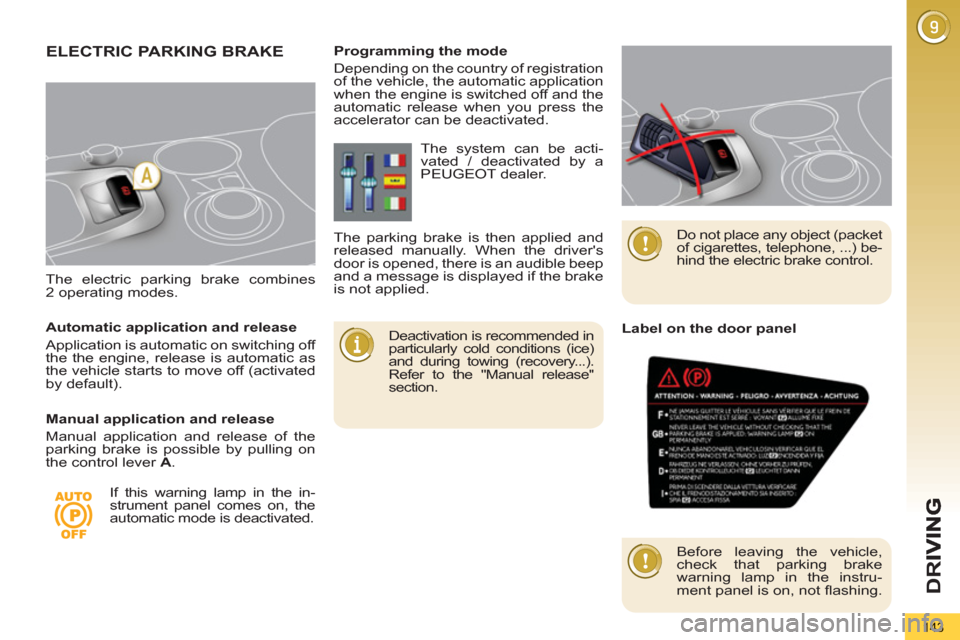
D
R
143
The electric parking brake combines
2 operating modes.
ELECTRIC PARKING BRAKE
Deactivation is recommended in
particularly cold conditions (ice)
and during towing (recovery...).
Refer to the "Manual release"
section.
Programming the mode
Depending on the country of registration
of the vehicle, the automatic application
when the engine is switched off and the
automatic release when you press the
accelerator can be deactivated.
If this warning lamp in the in-
strument panel comes on, the
automatic mode is deactivated. The system can be acti-
vated / deactivated by a
PEUGEOT dealer.
The parking brake is then applied and
released manually. When the driver's
door is opened, there is an audible beep
and a message is displayed if the brake
is not applied.
Do not place any object (packet
of cigarettes, telephone, ...) be-
hind the electric brake control.
Automatic application and release
Application is automatic on switching off
the the engine, release is automatic as
the vehicle starts to move off (activated
by default).
Manual application and release
Manual application and release of the
parking brake is possible by pulling on
the control lever A
.
Label on the door panel
Before leaving the vehicle,
check that parking brake
warning lamp in the instru-
ment panel is on, not fl ashing.
Page 147 of 284
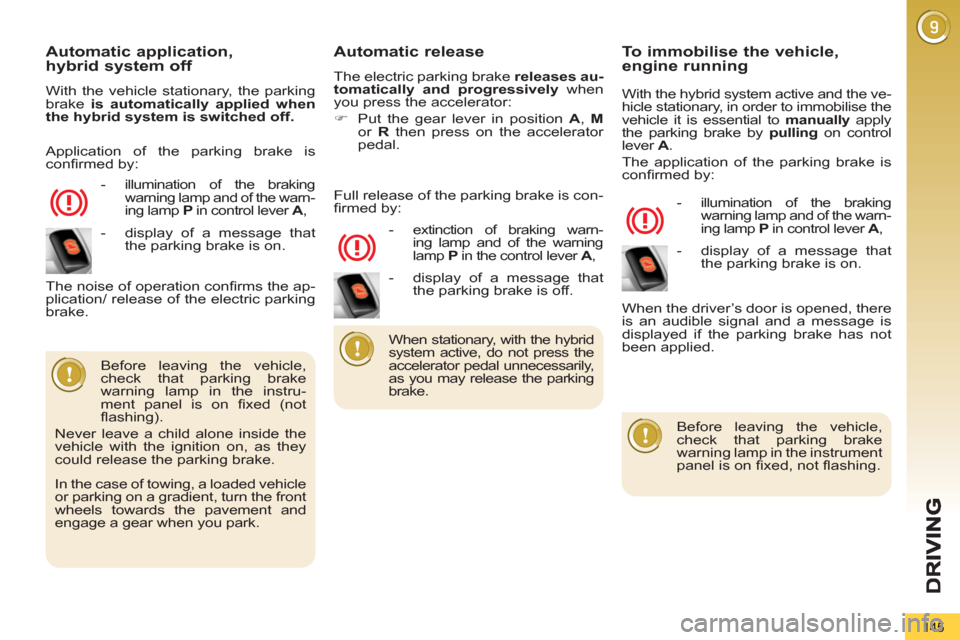
145
Automatic application,
hybrid system off
With the vehicle stationary, the parking
brake is automatically applied when
the hybrid system is switched off.
- illumination of the braking
warning lamp and of the warn-
ing lamp P
in control lever A
,
Automatic release
The electric parking brake releases au-
tomatically and progressively
when
you press the accelerator:
�)
Put the gear lever in position A
, M
or R
then press on the accelerator
pedal.
Before leaving the vehicle,
check that parking brake
warning lamp in the instru-
ment panel is on fi xed (not
fl ashing).
Never leave a child alone inside the
vehicle with the ignition on, as they
could release the parking brake.
- extinction of braking warn-
ing lamp and of the warning
lamp P
in the control lever A
,
The noise of operation confi rms the ap-
plication/ release of the electric parking
brake. Full release of the parking brake is con-
fi rmed by:
To immobilise the vehicle, engine running
With the hybrid system active and the ve-
hicle stationary, in order to immobilise the
vehicle it is essential to manually apply
the parking brake by pulling
on control
lever A
.
The application of the parking brake is
confi rmed by:
- illumination of the braking
warning lamp and of the warn-
ing lamp P
in control lever A
,
When the driver’s door is opened, there
is an audible signal and a message is
displayed if the parking brake has not
been applied.
Before leaving the vehicle,
check that parking brake
warning lamp in the instrument
panel is on fi xed, not fl ashing.
When stationary, with the hybrid
system active, do not press the
accelerator pedal unnecessarily,
as you may release the parking
brake.
Application of the parking brake is
confi rmed by:
- display of a message that
the parking brake is on.
In the case of towing, a loaded vehicle
or parking on a gradient, turn the front
wheels towards the pavement and
engage a gear when you park.
- display of a message that
the parking brake is off.
- display of a message that
the parking brake is on.
Page 162 of 284
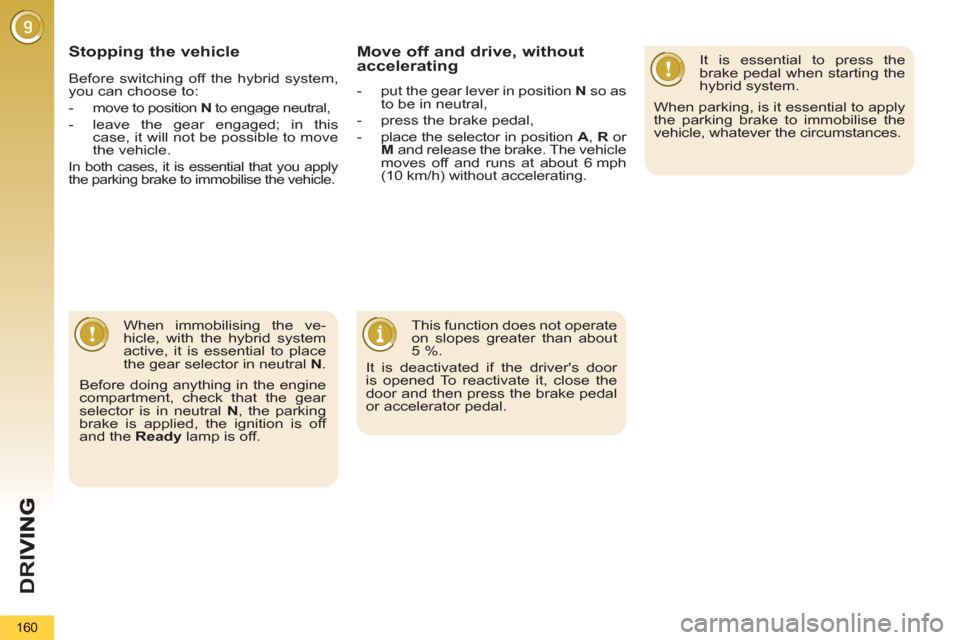
D
R
I
160
Stopping the vehicle
It is essential to press the
brake pedal when starting the
hybrid system.
When parking, is it essential to apply
the parking brake to immobilise the
vehicle, whatever the circumstances.
When immobilising the ve-
hicle, with the hybrid system
active, it is essential to place
the gear selector in neutral N
.
Before doing anything in the engine
compartment, check that the gear
selector is in neutral N
, the parking
brake is applied, the ignition is off
and the Ready
lamp is off.
Before switching off the hybrid system,
you can choose to:
- move to position N
to engage neutral,
- leave the gear engaged; in this
case, it will not be possible to move
the vehicle.
In both cases, it is essential that you apply
the parking brake to immobilise the vehicle.
Move off and drive, withoutaccelerating
- put the gear lever in position N
so as
to be in neutral,
- press the brake pedal,
- place the selector in position A
, R
or
M
and release the brake. The vehicle
moves off and runs at about 6 mph
(10 km/h) without accelerating.
This function does not operate
on slopes greater than about
5 %.
It is deactivated if the driver's door
is opened To reactivate it, close the
door and then press the brake pedal
or accelerator pedal.
Page 165 of 284
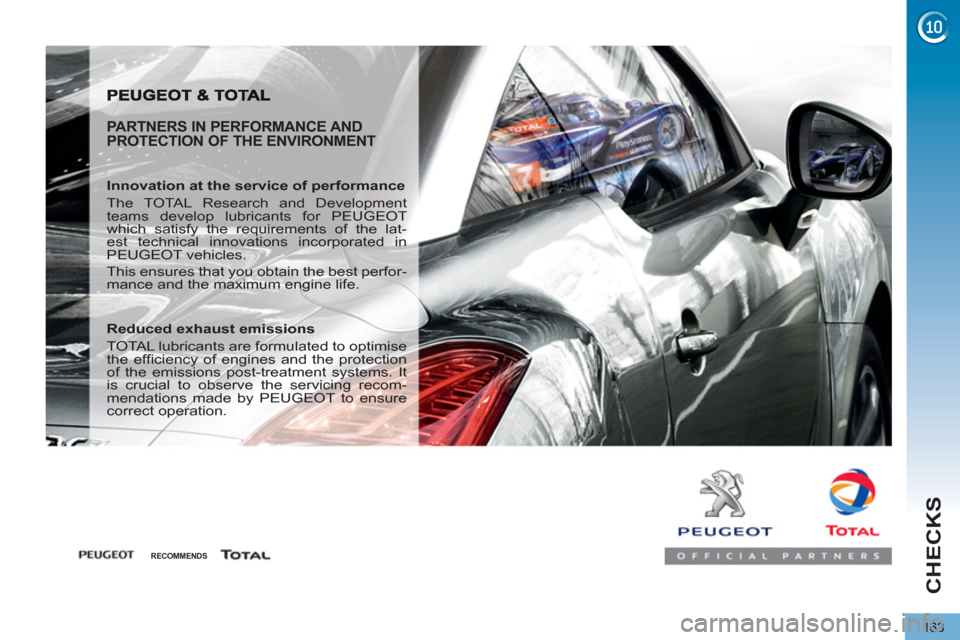
CHECKS
163
PARTNERS IN PERFORMANCE AND
PROTECTION OF THE ENVIRONMENT
Innovation at the service of performance
The TOTAL Research and Development
teams develop lubricants for PEUGEOT
which satisfy the requirements of the lat-
est technical innovations incorporated in
PEUGEOT vehicles.
This ensures that you obtain the best perfor-
mance and the maximum engine life.
Reduced exhaust emissions
TOTAL lubricants are formulated to optimise
the effi ciency of engines and the protection
of the emissions post-treatment systems. It
is crucial to observe the servicing recom-
mendations made by PEUGEOT to ensure
correct operation.
RECOMMENDS
Page 166 of 284
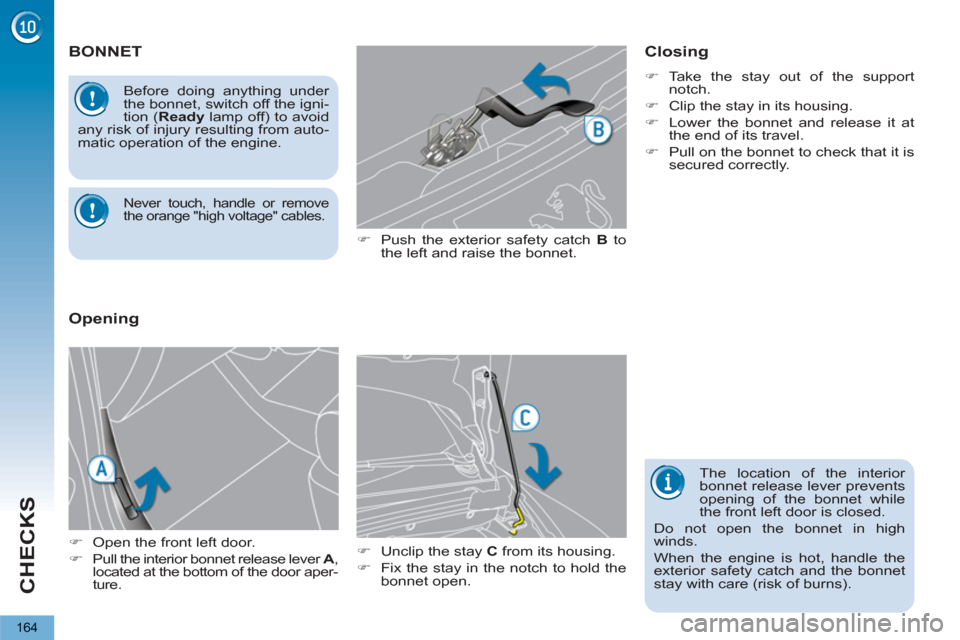
CHECKS
164
BONNET
�)
Push the exterior safety catch B
to
the left and raise the bonnet.
�)
Unclip the stay C
from its housing.
�)
Fix the stay in the notch to hold the
bonnet open.
Closing
�)
Take the stay out of the support
notch.
�)
Clip the stay in its housing.
�)
Lower the bonnet and release it at
the end of its travel.
�)
Pull on the bonnet to check that it is
secured correctly.
Opening
The location of the interior
bonnet release lever prevents
opening of the bonnet while
the front left door is closed.
Do not open the bonnet in high
winds.
When the engine is hot, handle the
exterior safety catch and the bonnet
stay with care (risk of burns).
Before doing anything under
the bonnet, switch off the igni-
tion ( Ready
lamp off) to avoid
any risk of injury resulting from auto-
matic operation of the engine.
�)
Open the front left door.
�)
Pull the interior bonnet release lever A
,
located at the bottom of the door aper-
ture.
Never touch, handle or remove
the orange "high voltage" cables.